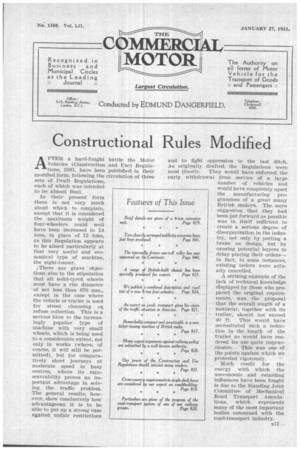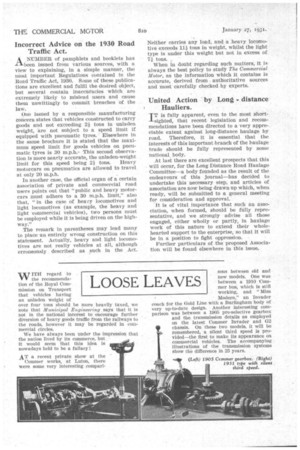Constructional Rules Modified
Page 35

Page 36

If you've noticed an error in this article please click here to report it so we can fix it.
AFTER a hard-fought battle the Motor Vehicles (Construction and Use) Regulations, 1931, have been published in their modified form, following. the circulation of tree sets of Draft Regulations, each of which was intended to be almost final. .
In their present form there is not very much about which to complain, except that it is considered the maximum weight of four-wheelers could well have been increased to 14 tons, in place of 12 tons, as this Regulation appears tobe aimed particularly at that very useful and economical type of machine, the eight-tonner.
There are grave objections also to the stipulation that all solid-tyred wheels must have a rim diameter of not less than 670. mm., exCept in the case where the vehicle or trailer is used for street cleansing ot refuse collection. This is a serious blow to the increasingly popular type of machine with very small wheels, which Is being used to a considerable extent, not only in works (where, of course, it will still he permitted), but for comparatively short journeys at moderate speed in busy centres, where its manoeuvrability proves an important advantage in solving the traffic problem. The general results, however, show conclusively how advantageous it is to be able to put up a strong case against unfair restrictions and to fight oppression to the last ditch. As originally drafted, the Regulations were most drastic. They would have enforced the early withdrawal from service of a large number of vehicles and would have completely upset the manufacturing programmes of a great many British makers. The mere suggestion that they had been Put forward as possible was in itself sufficient to create a serious degree of disorganization in the industry, not only by putting a brake on design, but by causing potential buyers to delay placing their orders— in fact, in some instances, existing orders were actually cancelled.
A striking example of the lack of technical knowledge displayed by those who prepared the original requirements, • was, the proposal that' the overall length of a motorcar, together with its trailer, should not exceed '40 ft. This would have necessitated such . a reduc._tion . in the_ length of the • trailer as would have rendered its use quiteiinpraceticable. This was one of the points. against which we protested vigorously.
Much credit for the energy with which the uneconomic and retarding influences have been fought Is due to the Standing Joint Committee of Mechanical Road Transport Associations, which Tepresents many of the most important bodies concerned with the road-transport industry.
Incorrect Advice on the 1930 Road Traffic Act.
ANUMBER of pamphlets and booklets has been issued from various sources, with a view to explaining, in a simple manner, the Most important Regulations contained in the Road Traffic Act, 1930. Some of these publications are excellent and fulfil the desired object, but several contain inaccuracies which are extremely likely to mislead users and cause them unwittingly to commit breaches of the law.
One issued by a responsible manufacturing concern states that vehicles constructed to carry goods and not exceeding 2i tons in unladen. weight, are not subject to a speed limit if equipped with pneumatic tyres. Elsewhere in the same brochure it is stated that the maximum speed limit for goods vehicles on pneumatic tyres is 30 m.p.h.This second observation is more nearly accurate, the unladen-weight limit for this speed being 2i tons. Heavy motorcars on pneumatics are allowed to travel at only 20 m.p.h.
In another case, the official organ of a certain association of private and commercial road users points out that "public and heavy motorcars must adhere to a 30 m.p.h. limit," also that, "in the case of heavy locomotives and light locomotives (as example, the heavy and light 'commercial vehicles), two persons must be employed while it is being driven on the highway."
The remark in parentheses may lead many to place an entirely wrong construction on this statement. Actually, heavy and light locomotives are not really vehicles at all, although erroneously, described as such in the Act. Neither carries any load, and a heavy locomotive exceeds 11 tons in weight, whilst the light type is under this weight but not in excess of 7/ tons.
When in doubt regarding such matters, it is always the best policy to study The Commercial Motor, as the information which it contains is accurate, derived from authoritative sources and most carefully checked by experts.
United Action by Long distance Hauliers.
IT is fully apparent, even to the most shortsighted, that recent legislation and recommendations have been directed to a very appreciable extent against long-distance haulage by road. Therefore, it is essential that the interests of this important branch of the haulage trade should be fully represented by some national body.
At last there are excellent prospects that this will occur, for the Long Distance Road Haulage Committee—a body founded as the result of the endeavours of this journal—has decided to undertake this necessary step, and articles of association are now being drawn up which, when ready, will be submitted to a general meeting for consideration and approval.
It is of vital importance that such an association, when formed, should be fully representative, and we strongly advise all those engaged, either wholly or partly, in haulage work of this nature to extend their wholehearted support to the enterprise, so that it will be in a position to fight oppression.
Further particulars of the proposed Association will be found elsewhere in this issue.




































































































